Dark academia aesthetics blend the intellectual with the mysterious, creating spaces that feel like they belong in a vintage university or an old-world library.
Your living room can become a scholar’s sanctuary with these moody, literary-inspired designs that balance sophistication with comfort.
Here are transformative ideas that will help you create a space where you could imagine poets writing by candlelight or philosophers debating until dawn.
Floor-to-Ceiling Bookshelf Walls: The Ultimate Literary Statement
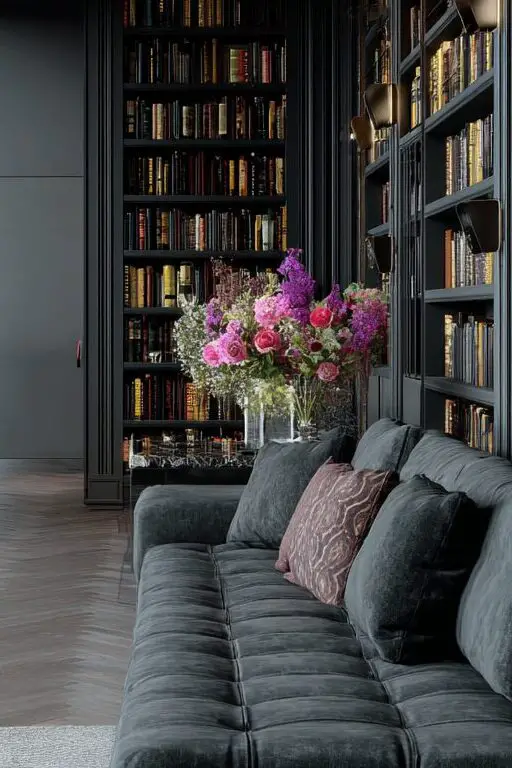
Nothing screams dark academia more than walls lined with antique books and leather-bound classics.
Installing floor-to-ceiling bookshelves transforms your living space into a personal library that exudes intellectual charm.
The key is to mix actual books with decorative elements – think brass bookends, small busts of philosophers, and vintage scientific instruments.
Don’t worry about filling every shelf immediately – collecting books over time adds authenticity to your space.
Opt for wooden shelves in dark mahogany, walnut, or ebony finishes to establish that timeless academic feeling.
Add a sliding ladder for reaching higher shelves, which serves as both a functional element and a dramatic visual statement.
For an extra touch of sophistication, install subtle LED lighting along select shelves to highlight your most treasured literary collections or antique objects.
The beauty of bookshelf walls is their ability to evolve with your interests – they become a living gallery of your intellectual journey.
Position your most visually striking books with their spines facing outward, occasionally placing some horizontally to break up the visual rhythm.
For authentic dark academia vibes, incorporate leather-bound encyclopedias, classic literature collections, and vintage academic journals.
Remember that imperfection adds character – slightly worn books with history tell a more interesting story than perfectly matched new volumes.
Moody Color Palettes: Rich Tones for Intellectual Depths
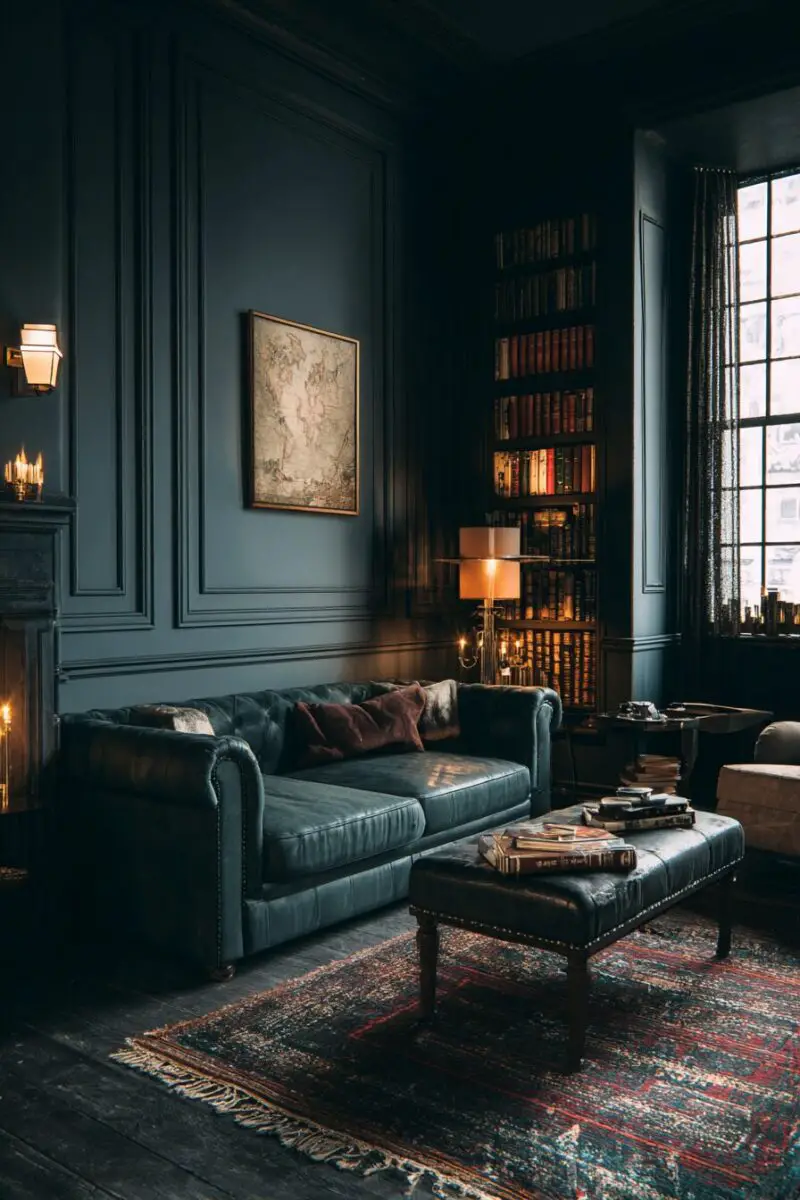
The foundation of any dark academia space begins with the right color palette – think rich, saturated hues that evoke scholarly gravitas.
Deep forest greens, burgundy reds, chocolate browns, and navy blues create the perfect backdrop for intellectual pursuits.
Avoid bright colors entirely – instead, embrace the shadowy elegance of muted, complex tones that feel like they’ve aged gracefully over decades.
Paint your walls in Benjamin Moore’s “Tarrytown Green” or Farrow & Ball’s “Book Room Red” for that perfect library ambiance.
For a more subtle approach, try deep taupe or charcoal gray walls with darker trim to create architectural interest.
Don’t be afraid of dark ceilings – painting overhead in a deep tone creates an enveloping atmosphere that’s surprisingly cozy rather than oppressive.
Incorporate black accents sparingly through picture frames, lamp bases, or furniture legs for sophisticated contrast.
Wood tones should complement your color scheme – seek out rich mahoganies, walnuts, and oaks with visible grain for authentic character.
Layer in metallics like antique brass, burnished gold, or aged copper through light fixtures and decorative objects for subtle warmth.
Remember that the dark academia palette isn’t about creating a gloomy space, but rather one with depth, history, and intellectual intrigue.
The right colors will make your books, artwork, and furnishings stand out while creating a cohesive scholarly atmosphere.
Design Your Dream Room in Minutes!
🏡 Start Creating FREE →Vintage Leather Furniture: Timeless Elegance with Character
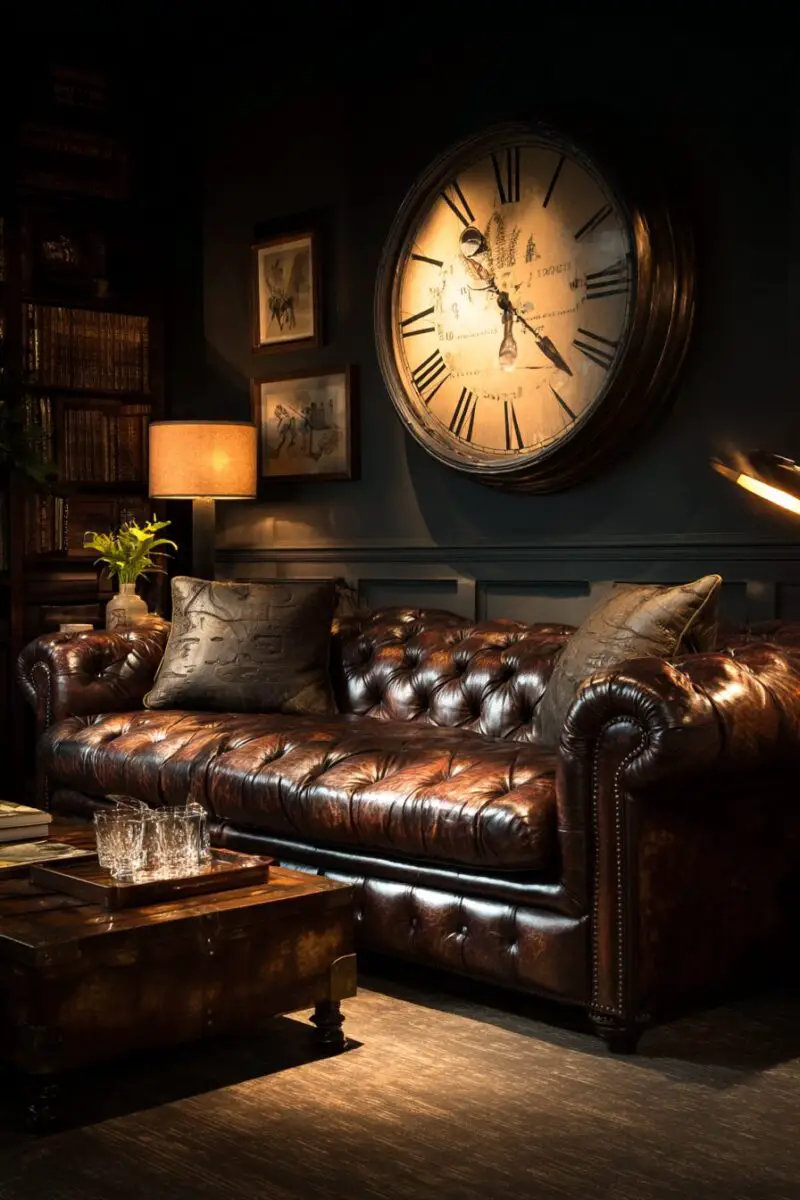
A well-worn leather Chesterfield sofa or wingback chair instantly establishes dark academia credibility in your living space.
Look for pieces in rich cognac, deep oxblood, or dark chocolate leather that show the beautiful patina of age and use.
The ideal dark academia leather has natural variations, slight cracking, and the softened edges that come from years of enjoyment.
Don’t be put off by vintage pieces with minor imperfections – these tell stories and add to the learned atmosphere you’re creating.
For authentic character, hunt through estate sales, auction houses, and vintage furniture stores rather than buying new reproductions.
If vintage shopping isn’t possible, many companies now artificially distress new leather furniture to give it that coveted lived-in appearance.
Pair your statement leather piece with contrasting textiles like wool throws and velvet pillows in deep, complementary colors.
For a complete seating arrangement, mix leather pieces with upholstered items in tweeds, plaids, or subtle herringbone patterns.
Position your leather furniture near bookshelves or reading lamps to create natural scholarly vignettes within your space.
Remember that genuine leather develops more character over time – your furniture will continue to evolve and tell your story for decades.
The tactile quality of leather creates an immediate sense of luxury and permanence that perfectly complements the dark academia aesthetic.
TRENDING NOW
Explore Magic With 10+ Afrohemian Decor IdeasAcademic Wall Art: From Classical Paintings to Vintage Maps
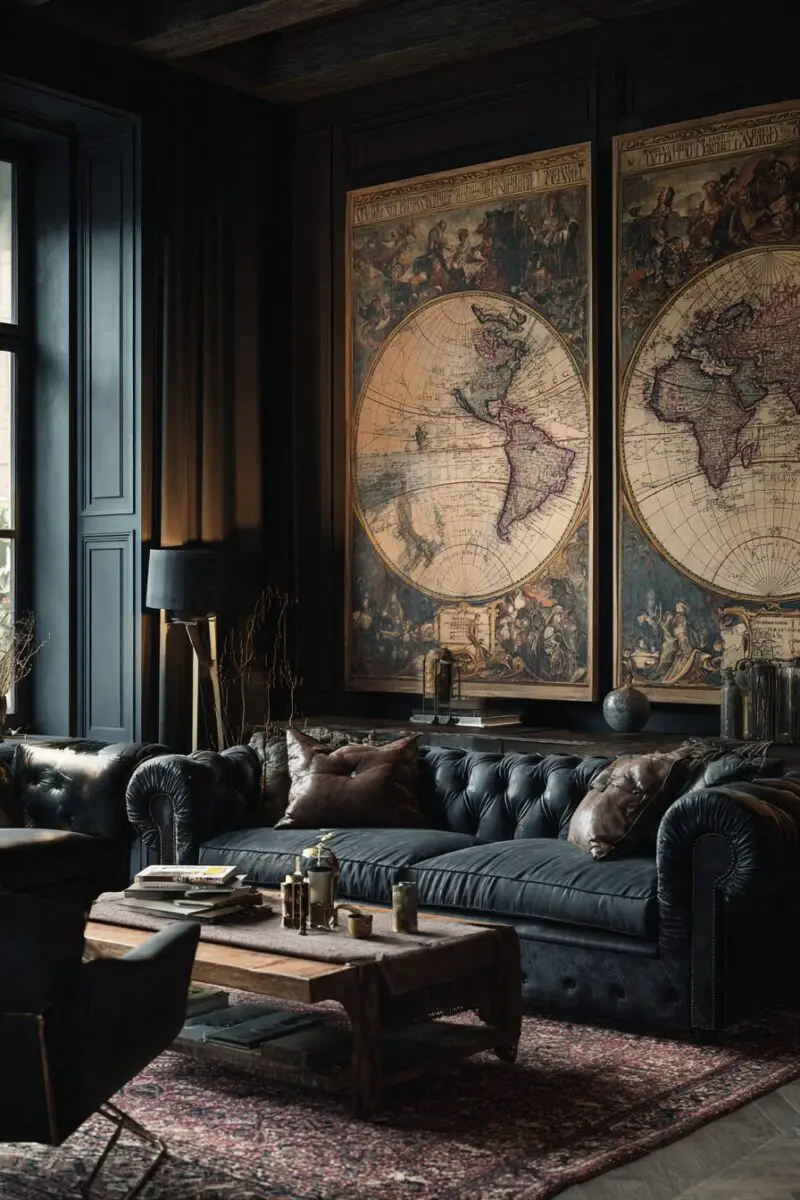
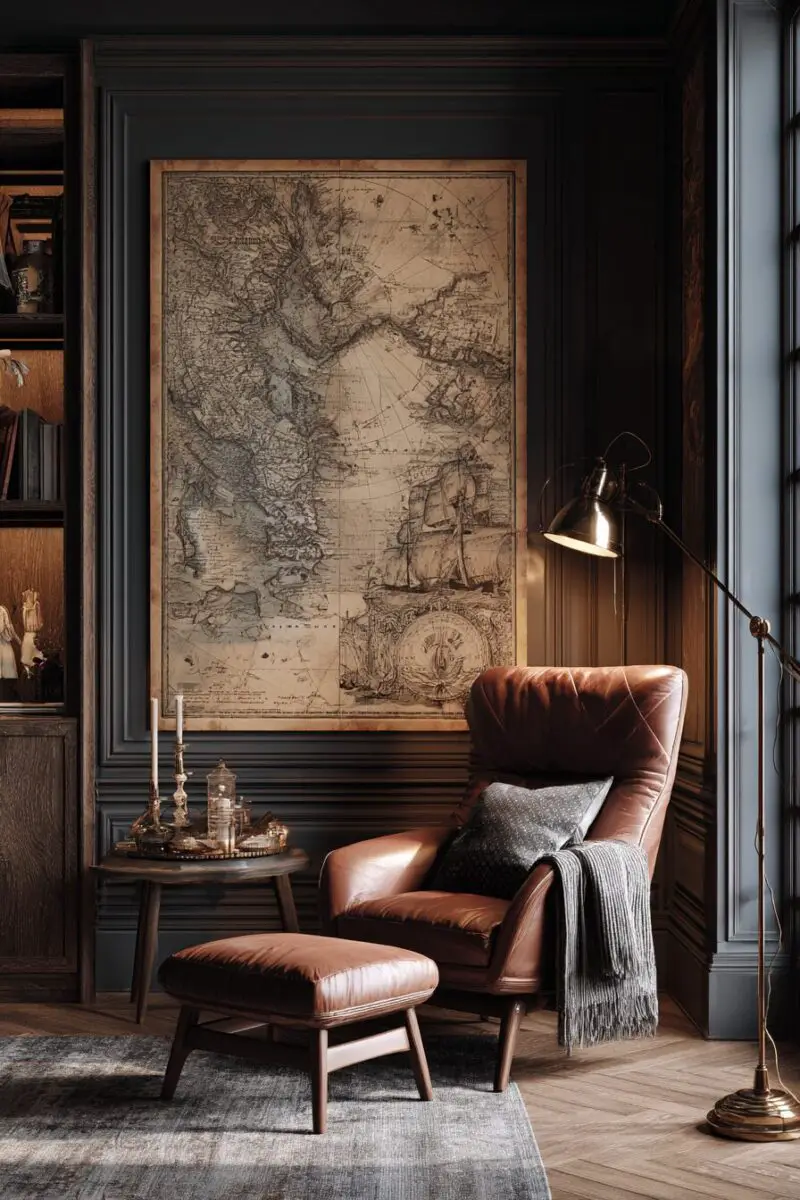
Your walls offer prime real estate for establishing dark academia credentials through carefully curated art selections.
Vintage anatomical charts, botanical illustrations, and astronomical maps bring scientific curiosity into your scholarly haven.
Black and white photography of historic university buildings, libraries, or museum interiors works beautifully in gallery wall arrangements.
Frame everything in dark wood, antique gold, or black frames with visible texture and weight – avoid thin, modern framing styles.
Vintage maps – particularly those showing ancient cities, historical boundaries, or nautical charts – add both visual interest and intellectual appeal.
Create impact with oversized art pieces that feature classical sculptures, architectural details, or moody landscape paintings.
Don’t overlook the power of text as art – framed pages from antique books, handwritten letters, or calligraphy samples make thoughtful additions.
For authenticity, mix professionally framed pieces with personal artifacts like pressed flowers from significant locations or handwritten notes.
Create a salon-style gallery wall that appears to have evolved over time, with pieces of varying sizes arranged with deliberate asymmetry.
Oil paintings with dark backgrounds and dramatic lighting (reminiscent of Rembrandt or Caravaggio) capture the essence of dark academia perfectly.
Remember that each art piece should feel like it has a story or intellectual significance – avoid generic decorative art without meaning.
Layered Lighting: Creating Ambiance with Antique Fixtures

Lighting sets the mood in a dark academia space – aim for a warm, golden glow rather than harsh overhead illumination.
Incorporate multiple light sources at different heights to create pools of light perfect for reading, conversing, or contemplating.
Vintage brass desk lamps with green glass shades evoke traditional library lighting and provide focused illumination for reading nooks.
Floor lamps with adjustable arms allow you to direct light precisely where needed for reading or highlighting art collections.
Seek out antique chandeliers with candle-style bulbs for dramatic overhead lighting that maintains the historical aesthetic.
Install dimmer switches on all lighting fixtures to control the intensity and create the perfect atmospheric conditions for different activities.
Table lamps with bases made from repurposed artifacts – think converted vintage scientific equipment or antique vessels – add unique character.
Don’t forget the transformative power of actual candles – groupings of pillar candles on mantels or tables create authentic flickering light.
For practical modern lighting, choose bulbs with warm color temperatures (2700K-3000K) that mimic the golden glow of traditional incandescent bulbs.
Hide LED strip lighting behind bookshelves to create a subtle glow that highlights your book collection without modernizing the look.
Remember that in dark academia spaces, shadows are as important as light – creating contrast between illuminated and darkened areas adds mystery and depth.
Statement Desk Area: The Scholar’s Corner in Your Living Space
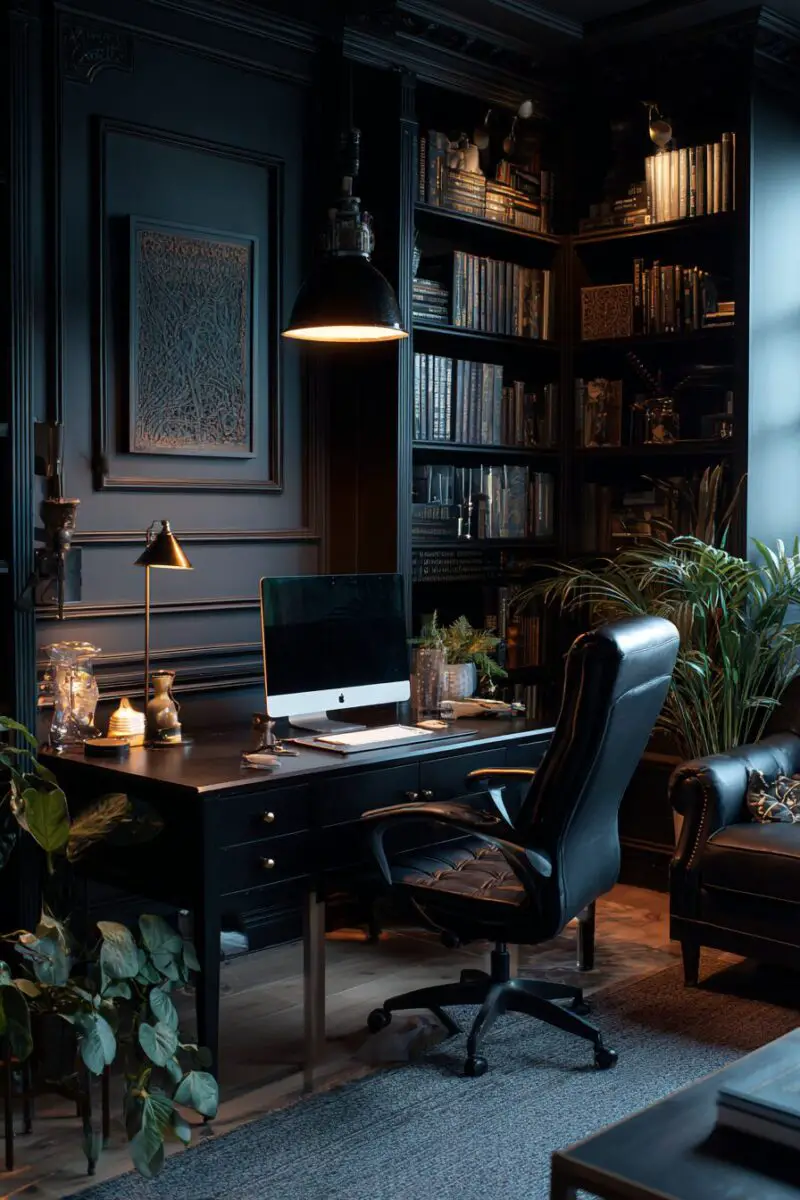
Every dark academia living room deserves a dedicated writing desk that beckons you to pen letters, jot down profound thoughts, or sketch observations.
Choose a substantial wooden desk with visible grain and character – look for carved details, leather inlays, or brass hardware.
Position your desk near a window for natural light during the day, but include a proper desk lamp for evening writing sessions.
Outfit your scholarly corner with traditional writing implements – a fountain pen collection, quality stationery, and perhaps a wax seal kit.
Incorporate organizational elements like wooden letter trays, vintage desk organizers, or brass paper weights that serve both function and decoration.
A comfortable chair with character is essential – consider a wooden swivel chair, a small leather armchair, or a velvet-upholstered desk chair.
Display a curated selection of reference books within arm’s reach – dictionaries, thesauruses, and subject-specific volumes relevant to your interests.
Add personal touches that reflect intellectual pursuits – a magnifying glass, a small globe, or framed specimens that inspire curiosity.
For practical modern needs, conceal technology in vintage-inspired containers – leather laptop sleeves or wooden boxes for charging cables.
Add a small bulletin board covered in dark velvet or linen where you can pin inspiration, notes, or meaningful ephemera.
Your desk area should feel like a natural extension of your living space while providing a dedicated zone for thought and creation.
Remember that the beauty of a dark academia desk lies in its used appearance – don’t be afraid to let this space show evidence of your intellectual life.
Textile Treasures: Tapestries, Velvet, and Woolen Comfort
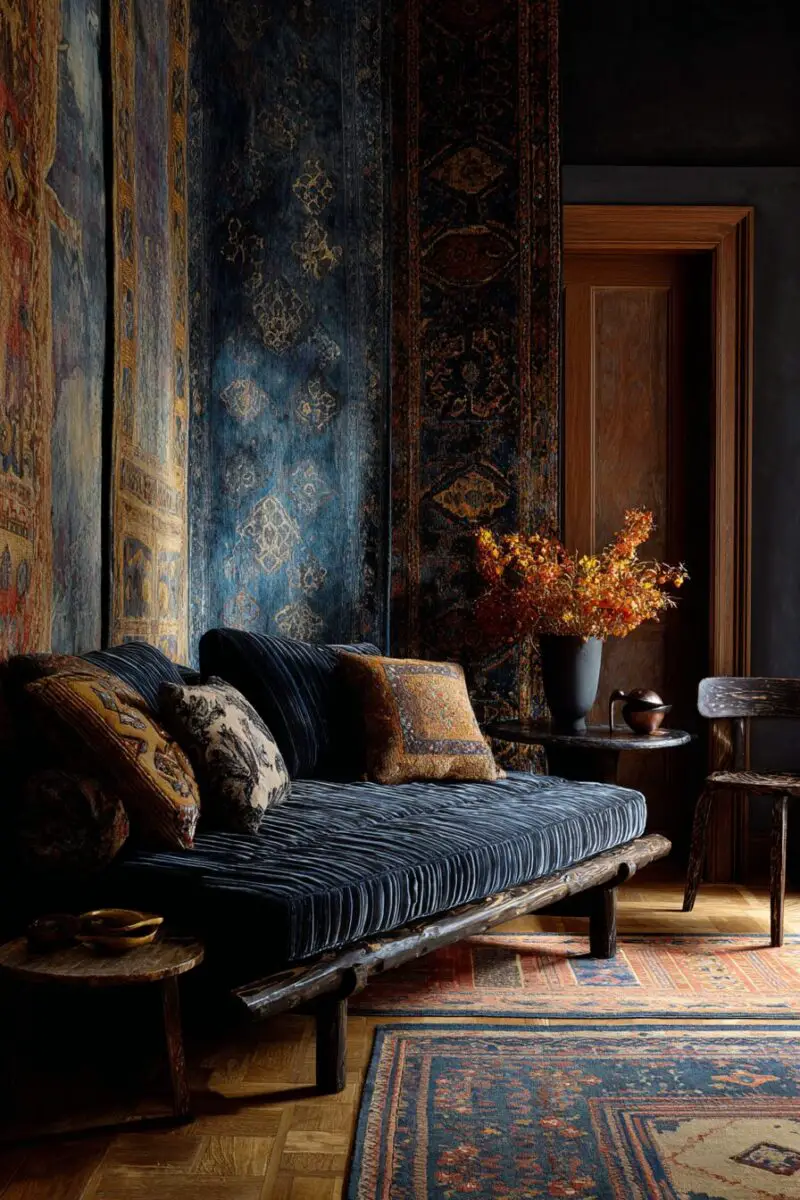
Textiles add essential warmth, texture, and acoustic comfort to dark academia spaces that might otherwise feel austere.
Incorporate heavy velvet curtains in deep jewel tones that pool slightly on the floor for dramatic window treatments.
Look for vintage wool rugs with traditional patterns in faded colors that suggest years of scholarly footsteps across their surface.
Layer multiple rugs of varying sizes and patterns for a collected-over-time appearance that adds visual and textural depth.
Drape woolen throws in plaids, herringbone, or cable knit patterns over leather furniture to create inviting reading nooks.
Put a tapestry as a statement wall hanging – traditional scenes, botanical motifs, or medieval-inspired designs work beautifully.
Select pillow covers in complementary rich textures – velvet, tweed, embroidered linen, or tapestry fabrics in coordinating deep colors.
Don’t overlook the impact of window treatments – heavy drapes with tiebacks create the perfect frame for rainy day contemplation.
For authentic academic charm, incorporate elements like leather or suede in unexpected places – perhaps as pillow covers or ottoman surfaces.
Mix patterns judiciously – combine larger traditional patterns with smaller geometrics while maintaining your color palette for cohesion.
Add a fabric-covered folding screen in a dark floral or toile pattern to create intimate zones within your living space.
Remember that textiles should invite touch and comfort – the dark academia aesthetic balances intellectual rigor with sensory pleasure.
Curiosity Collections: Curating Intellectual Displays
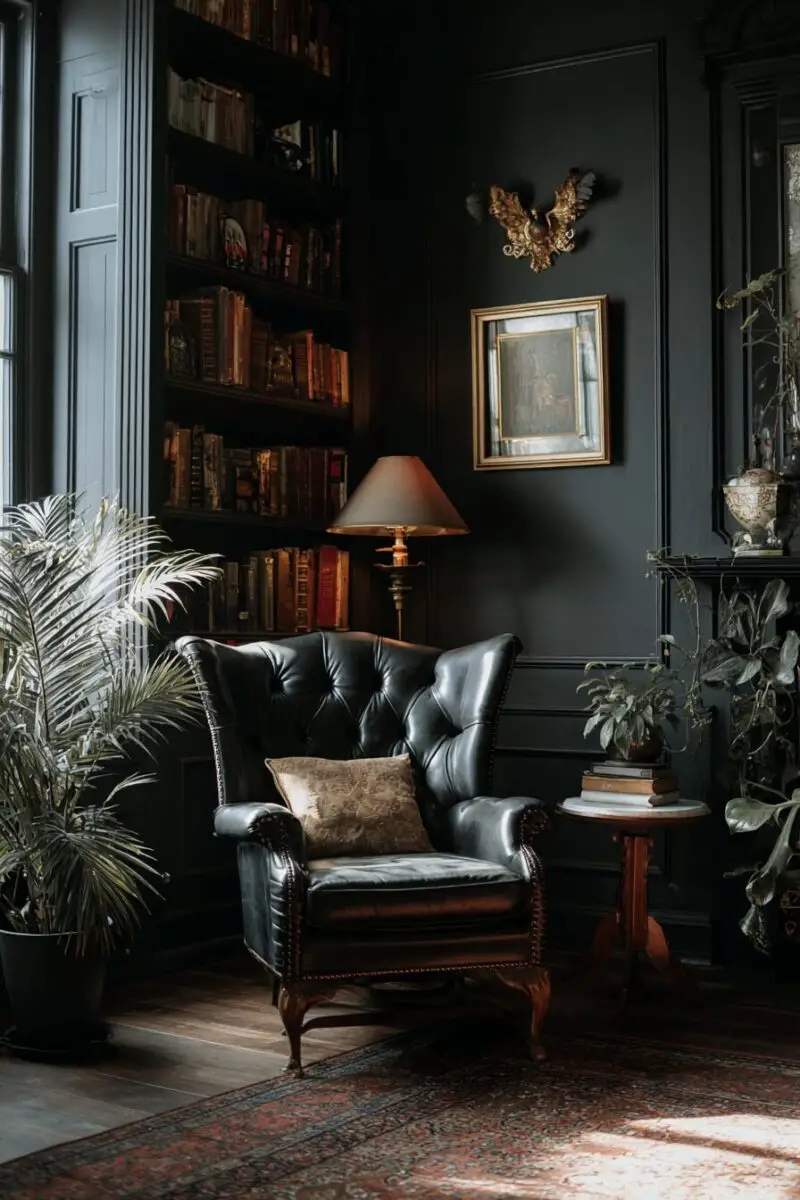
Thoughtfully arranged collections transform ordinary shelves into cabinets of curiosities that spark conversation and contemplation.
Look for vintage scientific instruments – brass microscopes, telescopes, or laboratory equipment with the patina of age.
Incorporate natural history elements like mineral specimens, preserved insects in frames, or botanical specimens under glass.
Group similar objects together for visual impact – a collection of antique hourglasses, vintage cameras, or carved wooden boxes.
Display collections on open shelving, under glass cloches, or in vintage display cases for proper curatorial presentation.
Seek out unusual antique items that prompt questions – phrenology heads, antique medical implements, or vintage laboratory glassware.
Balance your collections with books and personal mementos to avoid creating a museum-like atmosphere devoid of personal connection.
Remember that negative space is important – leave room between groupings to allow each collection to be appreciated individually.
Rotate your displays seasonally to maintain visual interest and showcase different aspects of your intellectual pursuits.
Lighting your collections appropriately draws attention to details and creates dramatic shadows that enhance the mysterious academic mood.
The best curiosity collections tell a story about your interests while maintaining aesthetic harmony with your overall design scheme.
Architectural Details: Crown Molding, Wainscoting, and Beyond
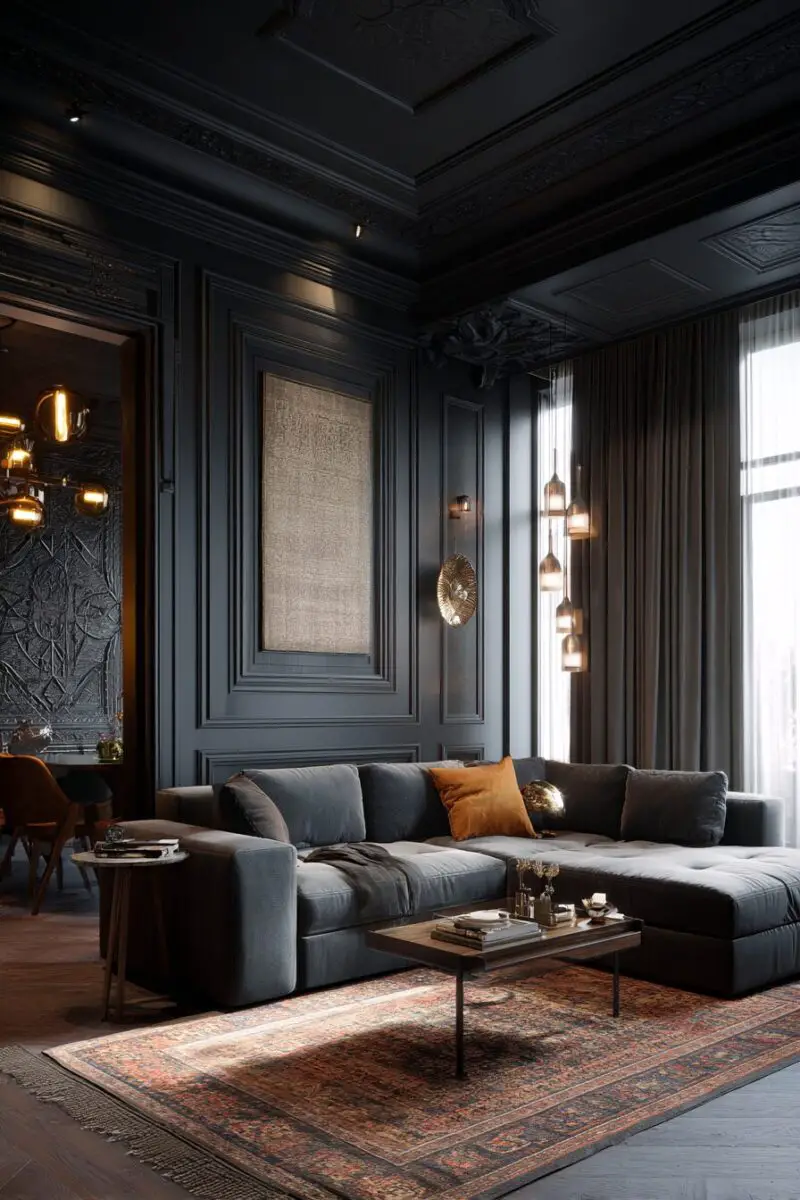
Architectural elements provide the perfect framework for dark academia interiors, creating spaces with historical gravitas.
Wainscoting or chair rail moldings create visual interest while protecting walls – paint these in glossy darker shades than your wall color for depth.
If you’re feeling ambitious, coffered ceilings or applied ceiling medallions transform ordinary rooms into scholarly sanctuaries.
Built-in bookshelves with architectural detailing like columns, arches, or decorative moldings create instant heritage appeal.
For rentals or budget-conscious makeovers, consider removable architectural wallpaper that mimics paneling, bookshelves, or intricate moldings.
Doorway arches, whether genuine or created through clever molding application, establish a classical academic atmosphere.
Ceiling beams – whether structural or decorative – add visual weight and historical context to your living space.
Window casings with substantial profiles painted in contrasting colors draw attention to natural light sources and frame your views.
For authentic old-world charm, seek out architectural salvage pieces like corbels, columns, or pediments to incorporate into your design.
Remember that symmetry plays an important role in classical architecture – balance your architectural additions for the most satisfying aesthetic.
Natural Elements: Bringing the Gothic Garden Indoors

Natural elements connect your scholarly sanctuary to the contemplative gardens and grounds of historic academic institutions.
Incorporate plants with dark, moody foliage like snake plants, ZZ plants, or ferns in antique ceramic or brass planters.
Display dried botanical elements – preserved eucalyptus, dried hydrangeas, or wheat sheaves – in vintage vessels for lasting arrangements.
Branches collected from walks can become sculptural elements when displayed in large vessels or mounted on walls.
Seek out botanical specimens like pressed flowers in antique frames or vintage botanical prints grouped as collections.
Natural wood elements with visible grain and character add warmth and organic texture to your scholarly environment.
Stone elements – marble bookends, alabaster lamps, or small classical busts – introduce cool, timeless textures.
For subtle natural fragrance, incorporate cedar blocks among books, dried lavender bundles, or natural beeswax candles.
Create vignettes that juxtapose the academic with the natural – a skull on a stack of books beside a potted fern creates perfect tension.
Remember that dark academia aesthetics often romanticize the connection between scholarly pursuits and the natural world – your space should reflect this relationship.
The beauty of this style lies in its imperfection and evolution – your space should continue to grow and change as you add meaningful objects and memories.
By embracing these ten elements, you’ve created more than a stylish room – you’ve established a personal sanctuary that honors knowledge, beauty, and the mysterious intersection between them.
Your dark academia living room now stands ready for rainy afternoons with classic novels, late-night philosophical discussions, or simply enjoying the atmospheric comfort of a space designed for both body and mind.


